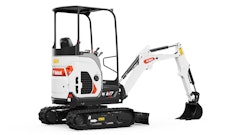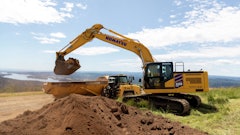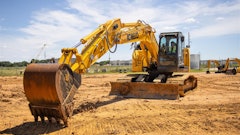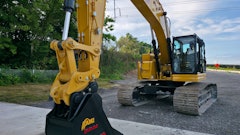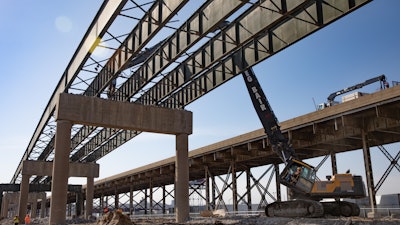
Information from this article was first published in Demolition Magazine and is being reused with permission from the National Demolition Association.
Greg Bair is used to demolishing big structures, but rarely does he get a project so large in his company’s hometown.
Greg Bair Track Hoe Service Inc., an National Demolition Association (NDA) member, is in the midst of demolishing a large interstate bridge connecting downtown Kansas City to the western suburbs. His crews and equipment are working in tight jobsite spaces surrounded by a busy section of town trafficked by cars and railroads.
“Kansas City is a small market,” Bair says. “There’s not a lot of big demolition.”
His crews are handling both the demo of the I-70 westbound bridge and the debris removal. Their work must be finished before the contractors hired to rebuild the new bridge can start construction. That means it’s critical that they are productive and meet deadlines. To help them get the job done, they’re using a high-reach excavator for some of the most challenging aspects of the project.
“Adding a high reach helped us stand out from the competition,” Bair says. “Customers know that we have the resources to get the job done and to do things the right way and safely.”
Specializing in difficult jobs
Bair knows the Kansas City market well. He started Greg Bair Track Hoe Service in 1990 with just one other employee and an excavator with a hoe ram attachment.
They started out breaking rock, but because they had the hoe ram, demolition companies began hiring them to help with demo jobs. Eventually, Bair was hired for his first bridge job — a 1,000-foot-long structure that was being restored — at a time when using hoe rams were a novelty in the bridge demolition business.
“Everything went great, and I thought, ‘Man, I like this better than breaking rock,’” he says.
The company mostly did smaller bridges at first, but as they proved their skill and grew their fleet, they started getting more jobs and bigger bridges. And they started venturing out of the Kansas City area with work as far as the East Coast.
Their footprint remains large, and the company has grown with the success, employing around 30 people and earning a reputation as one of the best demolition companies in the U.S. Around 70% of their work is demolition, with their services including heavy demolition, bridges, commercial buildings and some residential work. They complete 40 to 50 bridge demolition projects a year, and approximately 700 total jobs annually.
Bair believes his success is built on maintaining personal relationships and enjoying difficult, more unusual work.
“I love tearing stuff down,” Bair says. “I’ve always looked for the odd jobs — the harder ones that most people weren’t interested in.”
He also tries to stay within their specialty.
“We like tedious track hoe work,” Bair says. “We’re not into grading dirt or bulk moving of anything.”
Bair’s focus on consistency includes his fleet, which contains more than 40 excavators. He wants as many of them as possible to be the same brand, which he believes creates efficiencies for everything from familiarity with machines by his operators and mechanics to storing spare parts.
“I think I am brand picky,” he says. “Besides looking out for my overall business, I’m an operator myself. I want stout machines that can handle demo work — but also run smooth. And in today’s world, I’m looking at the technology on the machines.”
After buying a Volvo EC480 HR high-reach excavator a few years ago, Bair is going through the process of switching his entire fleet to Volvo machines.
“We were starting to bid on bridge demolitions that are larger and old, and the conventional ways of taking down stuff just wasn’t flying,” Bair says. “I knew a high reach was the machine we needed.”
Bair spent close to a year studying high reaches before concluding he wanted the Volvo high-reach excavator. Bair believes he has the only high reach in the Kansas City area, which gives his company an advantage when bidding on projects.
“It makes some customers feel they can call us and we have the right machine for the job,” Bair says. “It may not always do a large volume of work on a job, but it puts 10 other track hoes to work because we got the job because we had the right machine.”
Interstate bridge demolition
Demolition of the I-70 bridge connecting downtown Kansas City to Kansas started in February 2018. Officials expect to have the 50-year-old structure torn down and replaced within two years.
Approximately 45,000 cars passed over the bridge each day prior to the start of demolition. Many of those drivers are still using a nearby eastbound bridge.
The I-70 demolition fits right in with the types of challenging projects Bair enjoys. This is a large project the Kansas Department of Transportation spent five years planning. State officials decided in 2012 that rebuilding the interstate bridge from scratch would be cheaper than trying to maintain and repair the old one. The age and size of the Lewis and Clark Viaduct, a series of bridges that connects Kansas City, KS, to Kansas City, MO, makes the job challenging. But that’s nothing new for Bair’s crews.
“We have torn down many, many bridges,” says John JoRay, a supervisor and equipment operator at Greg Bair Track Hoe Service. “We have got it down pretty good.”
Bair’s crew will use excavators to remove the bridge’s concrete deck along with the substructure on both land and water. The process requires them to work 30 feet underwater and position excavators on barges to work on pieces of the bridge that cross the Kansas River.
Part of the demolition included removing another high beam floor system on top of the steel truss while working over the river.
“The challenges of this bridge are the tight conditions,” Bair says. “We have a railroad track next to it. The railroad crosses under the bridge twice, and it crosses over a railroad truss bridge.”
Bair’s crews underwent special railroad training and created a thorough safety plan to prepare. So far, everything appears to be on schedule.
“We’ve been in a pretty good rhythm,” says Andy Shorten, an estimator and project manager at Greg Bair Track Hoe Service.
Using the high reach
The Volvo EC480 HR high-reach excavator has played a critical role in the I-70 bridge demolition. Working with such a tall structure in tight conditions can be challenging. The Kansas Department of Transportation broke the demolition up into two phases. Bair’s team was charged with taking down the river span first.
The bridge is 4,000 feet long and 70 feet wide. Shorten expects they will remove 15,000 yards of concrete rubble during the demolition project.
The EC480 HR has an 89-foot, 6-inch boom and arm, but Shorten expects 75 feet to be the max needed on the bridge demolition.
“We are using that to run through and cut all the diaphragms loose in between girders, and they’ll be lifted off with a crane,” Shorten says. “It’s a lot faster and safer than having someone in a lift using a torch set to remove them. You can stay away from the work a lot better.”
They’ll also use a hoe ram attachment on the high reach to take down the tall piers. Between that and the other work the excavators are doing on the project to remove the bridge deck, substructure and piers, the machines must be productive and efficient in demanding conditions. While a challenge, that’s also pretty common on the types of projects Greg Bair Track Hoe Service tackles.
“We’re doing demo, so we’re going to put the machine to its test,” Bair says. “You can’t always put the perfect machine on the job. Maybe there’s not enough room, so I take a smaller excavator to do something that, ideally, a bigger one should be doing. Is it going to withstand it? Am I going to tear it up doing? So, I’m looking at how tough the excavators are built.”
Alex Schuman is a technical writer at Two Rivers Marketing in Des Moines, Iowa.


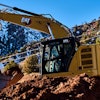
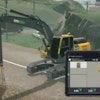
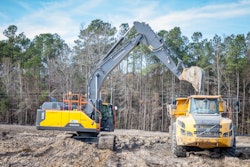
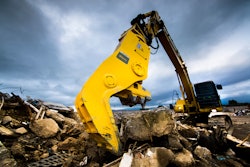
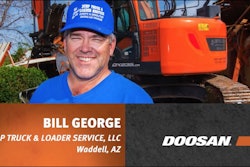






![Hcm Ax Landcros Dual Branded Logo[25]](https://img.forconstructionpros.com/mindful/acbm/workspaces/default/uploads/2025/11/hcmaxlandcros-dual-branded-logo25.Qhg3vUCjoK.jpg?ar=16%3A9&auto=format%2Ccompress&bg=fff&fill-color=fff&fit=fill&h=135&q=70&w=240)
